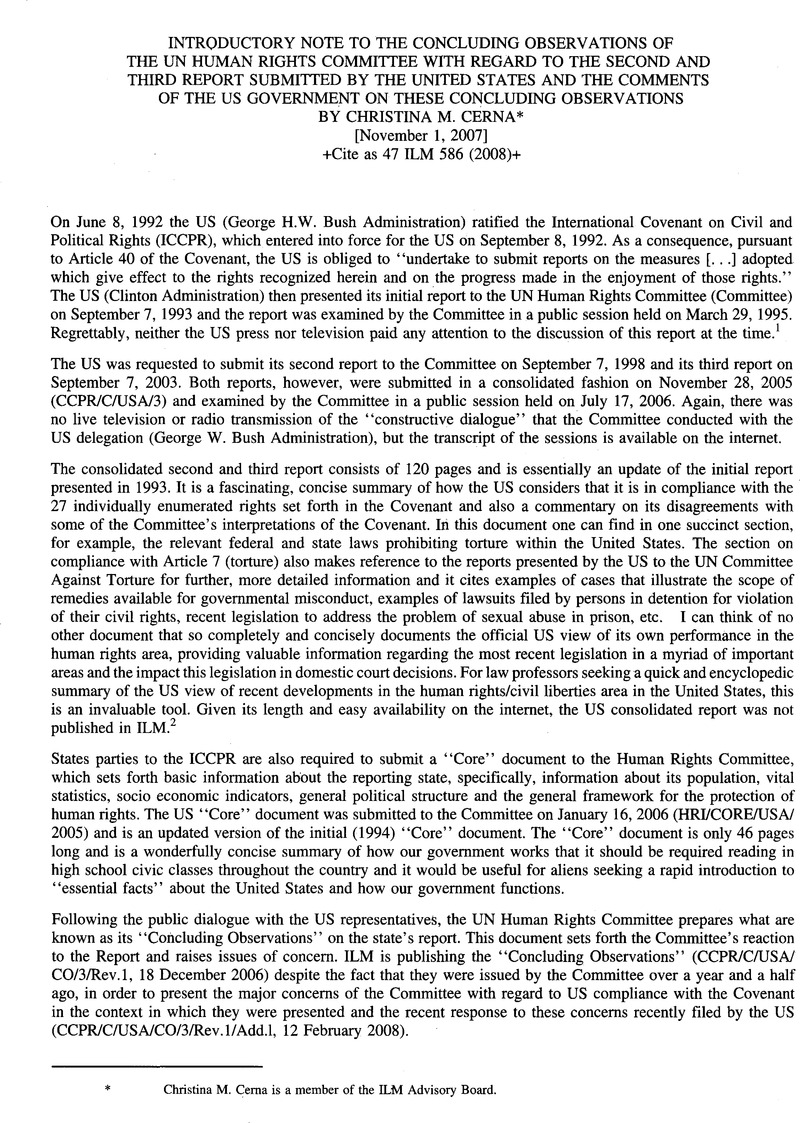No CrossRef data available.
Article contents
The Concluding Observations of the UN Human Rights Committee With Regard to the Second and Third Report Submitted by the United States and the Comments of the US Government on these Concluding Observations
Published online by Cambridge University Press: 27 February 2017
Abstract

- Type
- International Legal Documents
- Information
- Copyright
- Copyright © American Society of International Law 2008
References
Endnotes
1 Human rights activists sought to interest C-SPAN, National Public Radio, PBS television to carry the hearing live but there was no interest.
2 The most user-friendly website, in my opinion, for all relevant UN treaty body documents mentioned in this Introductory Note is www.bayefsky.com.
3 The US reservation states “That the United States reserves the right, subject to its Constitutional constraints, to impose capital punishment on any person (other than a pregnant woman) duly convicted under existing or future laws permitting the imposition of capital punishment, including such punishment for crimes committed by persons below eighteen years of age.”
4 See CCPR/C/USA/3 para. 468.
5 Ibid. para. 469.
6 See Extraterritorial Application Of Human Rights Treaties, ed. Fons Coomans and Menno T. Kamminga, Intersentia (2004) for an extensive treatment of this issue. The prevailing view in the literature today is that the competence of a state is primarily territorial but could apply extraterritorially in exceptional cases, such as those in which the extraterritorial act was capable of falling within the jurisdiction of the respondent state. The Committee finds a state responsible in those areas where it exercised effective jurisdiction and effective control, for example, Israeli responsibility in the occupied territories.
7 See CCPR/C/USA/CO/3/Rev. I/Add. 1, section on para. 14.
8 See CCPR/C/USA/CO/3/Rev. I/Add. 1, section on para. 12.
9 See CCPR/C/USA/CO/3/Rev. I/Add. 1, section on para. 20.
* This text was reproduced and reformatted from the text appearing at the U.S. State Department website (visit June 6,2008) <http://www.state.gov/documents/organization/100845.pdf>
1 See Human Rights Committee, Concluding Observations of the Human Rights Committee — United States of America. Doc. No. CCPR/C/USA/CO/3/Rev.l at para. 39 (Dec. 18, 2006).
2 See e.g., Statement by Eleanor Roosevelt, Summary Record of the Hundred and Thirty-Eighth Meeting, U.N. ESCOR Hum. Rts. Comm., 6th Sess., 138th mtg at 10, U.N. Doc. E/ CN.4/SR.138 (1950). This interpretation was also conveyed to the Human Rights Committee in 1995 by Conrad Harper, the Legal Adviser of the U-S. Department of State. In response to a question posed by the Committee, Mr. Harper stated that “Article 2 of the Covenant expressly stated that each State Party undertook to respect and ensure the rights recognized ‘to all individuals within its territory and subject to its jurisdiction.’ That dual requirement restricted the scope of the Covenant to persons under United States jurisdiction and within United States territory. During the negotiating history, the words ‘within its territory’ had been debated and were added by vote, with the clear understanding that such wording would limit the obligations to within a Party's territory. Summary record of the 1405th meeting: United States of America, UN ESCOR Hum. Rts. Comm., 53rd Sess., 1504th mtg. at ¶¶ 7, 20, U.N. Doc. CCPR/C/SR 1405 (1995).
3 Second and Third Periodic Report of the United States of America to the UN Committee on Human Rights Concerning the International Covenant on Civil and Political Rights, Annex 1, available at <http://www.state.gov/g/drl/rls/55504.htm> (Oct.21, 2005) [hereinafter “ICCPR Report”].
4 President Discusses Creation of Military Commissions to Try Suspected Terrorists, Office of the Press Secretary, available at <http://www.whitehouse.gov/news/releases/2006/09/20060906-3.html> (Sept. 6,2006).
5 Id.
6 Detainee Treatment Act of 2005, Pub. L. No. 109-148, Title X (Dec. 30, 2005).
7 See e.g., Geneva Convention Relative to the Protection of Civilian Persons in Time of War, August 12, 1949, art. 3, 75 UNTS 135.
8 Army Field Manual 2-22.3, Human Intelligence Collector Operations, para. 5-74.
9 Id. at para. 5-75.
10 Id. at paras. 5-76, 5-77.
11 Military Extraterritorial Jurisdiction Act of 2000, Pub. L. No.106-523, codified at 18 U.S.C. § 3261 et seq.
12 Uniform Code of Military Justice, Art. 2(a); 10 U.S.C. § 802(a).
13 ICCPR Report, supra note 3; List of Issues to Be Taken Up in Connection With the Consideration of the Second and Third Periodic Reports of the United States of America — Response of the United States of America, at para. 9, available at: <http://www.state.gov/g/drl/rls/70385.htm> [hereinafter “Response to List of Issues”].
14 Update to Annex One of the Second Periodic Report of the United States of America to the Committee Against Torture, available at: <http://www.state.gov/g/drl/rls/55712.htm> (Oct. 21, 2005).
15 The total summary of those receiving punishments, those cases requiring additional investigation, and those cases closed, do not equal 92, as cases may involve more than one defendant, and defendants can receive multiple types of punishment for their violation when convicted or otherwise disposed.
16 Response to List of Issues, supra note 13, at para. 10.
17 Hamdan v. Rumsfeld, 126 S.Ct. 2749 (2006).
18 Military Commissions Act of 2006, Pub. L. No. 109-366 (Oct. 17, 2006).
19 “Response to List of Issues,” supra note 16, at para. 16.
20 The Department of Justice currently operates a testing program dedicated to proactively uncovering housing discrimination. The program is conducted primarily through paired tests, an event in which two individuals—one acting as the “control group” (e.g., white male) and the other as the “test group” (e.g., black male)—pose as prospective buyers or renters of real estate for the purpose of determining whether a housing provider is complying with the fair housing laws.
* This text was reproduced and reformatted from the text appearing at the U.N. Human Rights website (visit June 6, 2008)<http://www.unhchr.ch/TBS/doc.nsf/el21f32fbc58faafcl256a2a0027ba24/34d0a773a44de02bcl25725a0034cbdf/$FILE/G0645961.doc>




